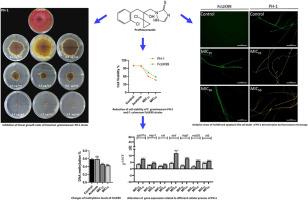原硫康唑对镰刀菌的作用方式及细胞毒性研究
IF 3.3
3区 农林科学
Q2 PLANT SCIENCES
引用次数: 0
摘要
通过基因组学、表观基因组学、转录组学和色谱学等方法,在细胞水平上研究了原硫康唑对禾本科镰刀菌PH-1和镰刀菌FcUK99对照菌株的影响。测定Prothioconazole对它们的最小抑制浓度(MIC)分别为1.2 μg/mL和1 μg/mL。MIC25和MIC50剂量(PH-1分别为0.3 μg/mL和0.6 μg/mL, FcUK99分别为0.25 μg/mL和0.5 μg/mL)降低了两种菌株的线性生长速率和细胞活力。此外,MIC50刺激FcUK99大分生孢子的产生并使其膨胀。通过2 ',7 ' -二氯双氢荧光素双醋酸酯染色,监测脂质过氧化水平,检测抗氧化酶活性及其转录物表达水平的变化,证明了原硫代康唑的氧化应激作用。吖啶橙/溴化乙啶染色、特异性基因表达变化测定和caspase-3活性监测显示凋亡样细胞死亡。相关性分析显示,细胞凋亡样死亡可能是由原硫康唑诱导的氧化应激引起的。偶联限制性内切酶-随机扩增和酶联免疫吸附试验表明,原硫康唑降低了基因组模板的5-mC含量和稳定性。薄层色谱分析结果表明,原硫康唑对FcUK99的脱氧雪腐镰刀菌醇产量没有影响,但对FcUK99的3-乙酰脱氧雪腐镰刀菌醇产量有影响。Real-time PCR结果显示,prothioconazole上调PH-1中tri5的表达,下调FcUK99中tri5的表达。此外,该化合物对HEK293和L929细胞无毒性。本研究表明,原硫康唑对镰刀菌的抑制作用强、复杂且具有物种特异性,同时对哺乳动物细胞无毒,是一种较好的抗真菌化合物。本文章由计算机程序翻译,如有差异,请以英文原文为准。

Investigation of the mode of action and cytotoxicity of prothioconazole on Fusarium phytopathogens
Prothioconazole's effects on Fusarium graminearum PH-1 and F. culmorum FcUK99 reference strains were investigated at the cellular level and via genomic, epigenomic, transcriptomic, and chromatographic approaches. Prothioconazole's minimum inhibitory concentrations (MIC) on them were determined as 1.2 μg/mL and 1 μg/mL, respectively. Its MIC25 and MIC50 doses (0.3 μg/mL and 0.6 μg/mL for PH-1; 0.25 μg/mL, and 0.5 μg/mL for FcUK99, respectively) reduced linear growth rates and cell viabilities in both strains. Additionally, MIC50 stimulated the macroconidia production of FcUK99 and swelled them. Oxidative stress effect of prothioconazole was demonstrated by 2′,7′-dichlorodihydrofluorescein diacetate staining, monitoring of lipid peroxidation levels, and detection of alterations of antioxidant enzyme activities and expression levels of their transcripts. Apoptosis-like cell death was shown by acridine orange/ethidium bromide staining, determination of specific gene expression changes, and monitoring of caspase-3 activity. The correlation analysis revealed that apoptosis-like cell death could have resulted from prothioconazole-induced oxidative stress. Coupled restriction enzyme digestion-random amplification and enzyme-linked immunosorbent assay revealed that prothioconazole reduced the 5-mC content and the genomic template stability. The thin layer chromatography indicated that prothioconazole did not affect deoxynivalenol production in both strains while reducing 3-acetyl deoxynivalenol production in FcUK99. Real-time PCR findings demonstrated that prothioconazole upregulated tri5 expression in PH-1, downregulated it in FcUK99. Moreover, this compound was not toxic to HEK293 and L929 cells. The study showed that prothioconazole was a suitable antifungal compound for controlling Fusarium spp. because of its strong, complex, and species-specific effects on these two phytopathogens while maintaining non-toxicity towards mammalian cells.
求助全文
通过发布文献求助,成功后即可免费获取论文全文。
去求助
来源期刊
CiteScore
4.30
自引率
7.40%
发文量
130
审稿时长
38 days
期刊介绍:
Physiological and Molecular Plant Pathology provides an International forum for original research papers, reviews, and commentaries on all aspects of the molecular biology, biochemistry, physiology, histology and cytology, genetics and evolution of plant-microbe interactions.
Papers on all kinds of infective pathogen, including viruses, prokaryotes, fungi, and nematodes, as well as mutualistic organisms such as Rhizobium and mycorrhyzal fungi, are acceptable as long as they have a bearing on the interaction between pathogen and plant.

 求助内容:
求助内容: 应助结果提醒方式:
应助结果提醒方式:


